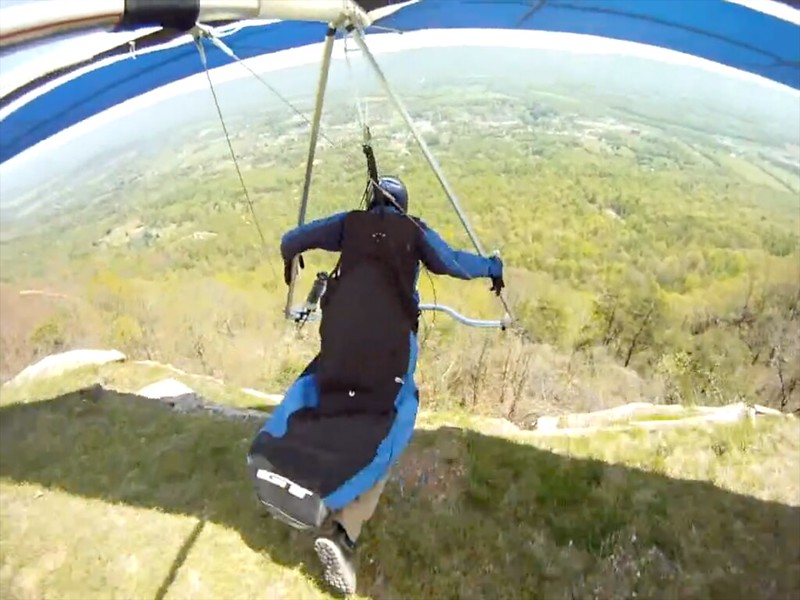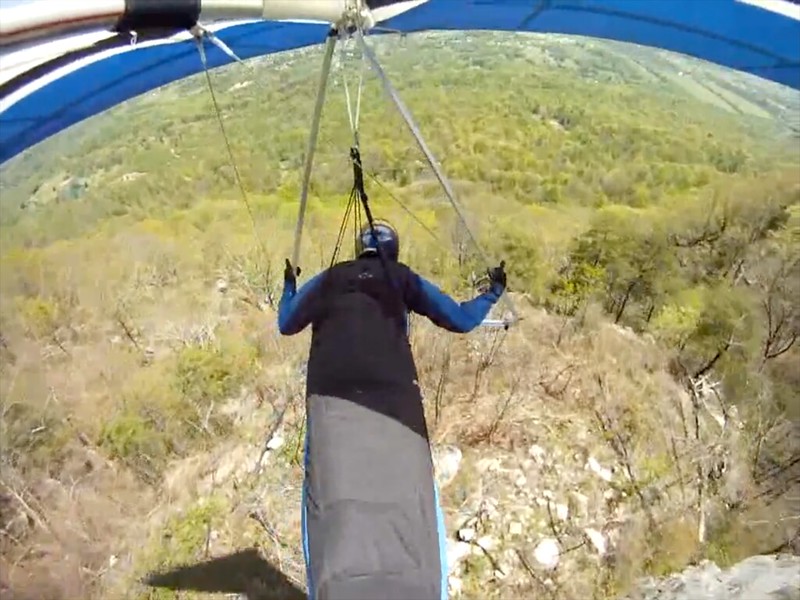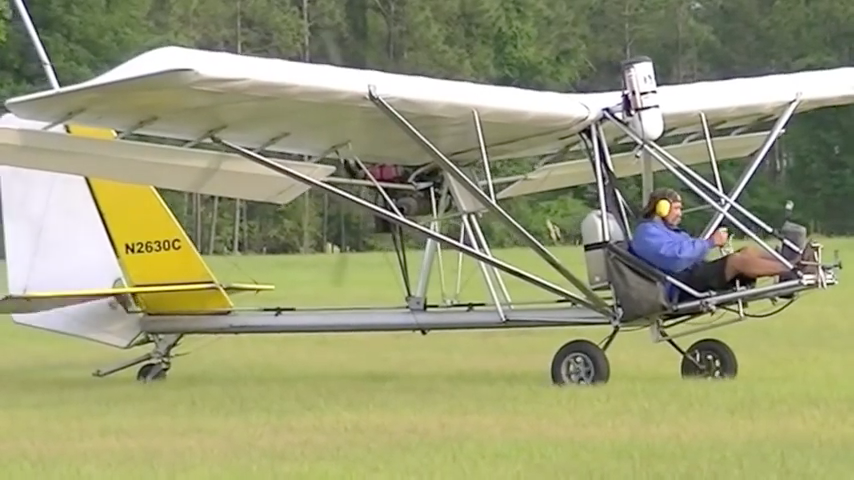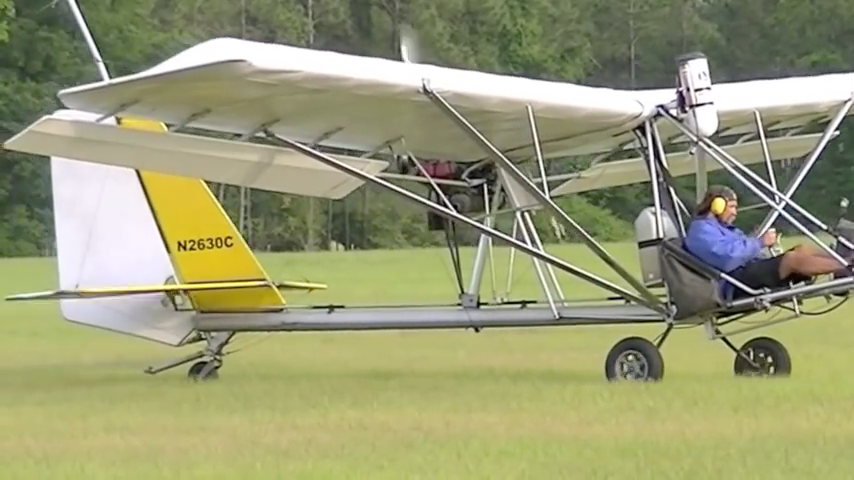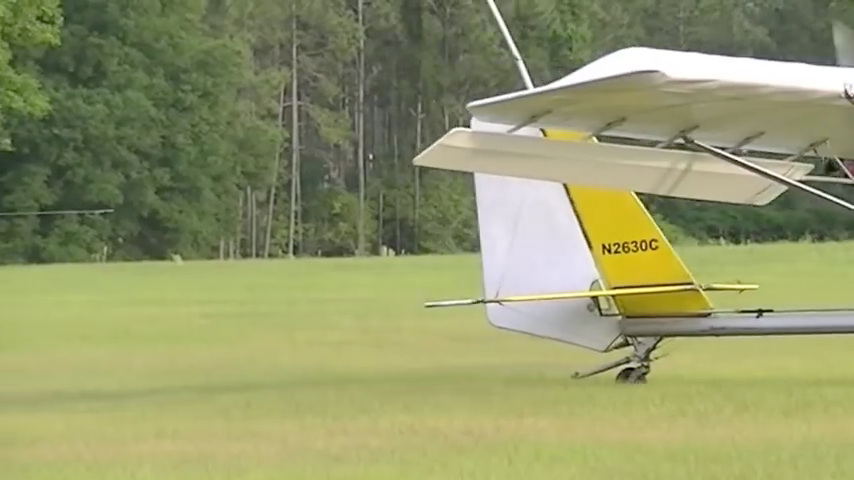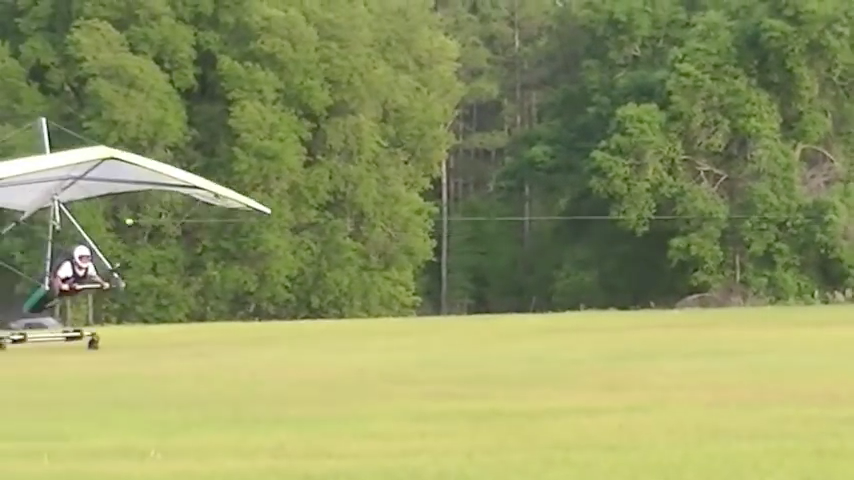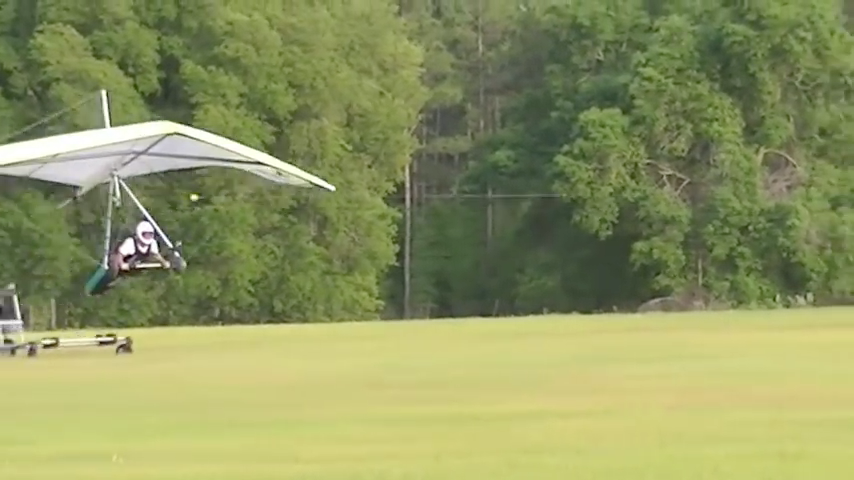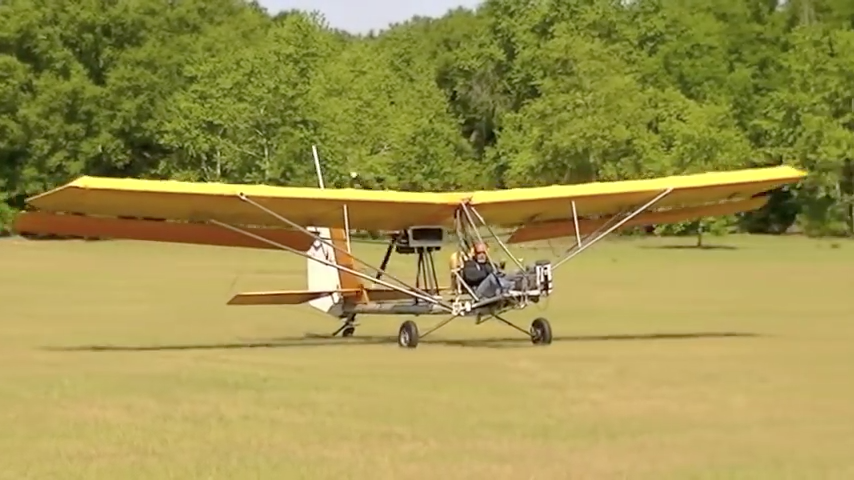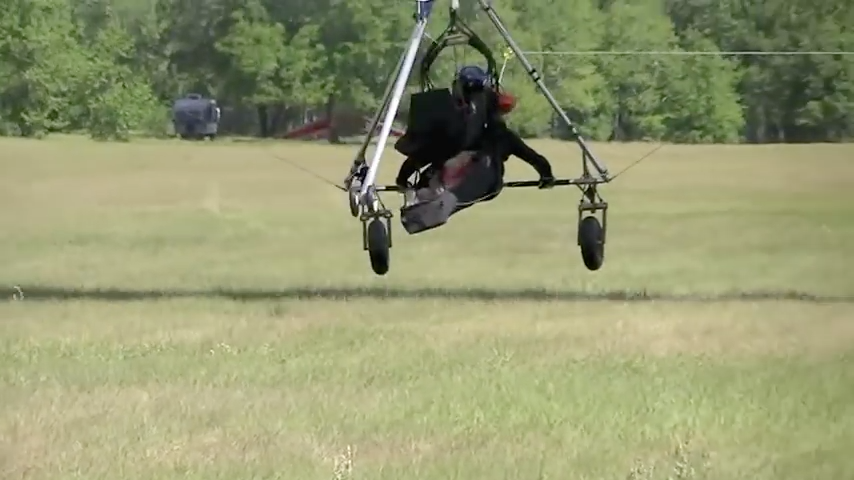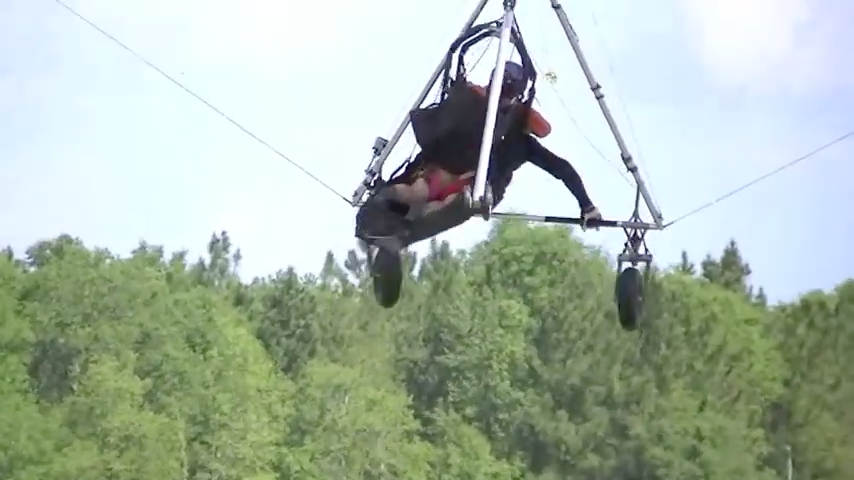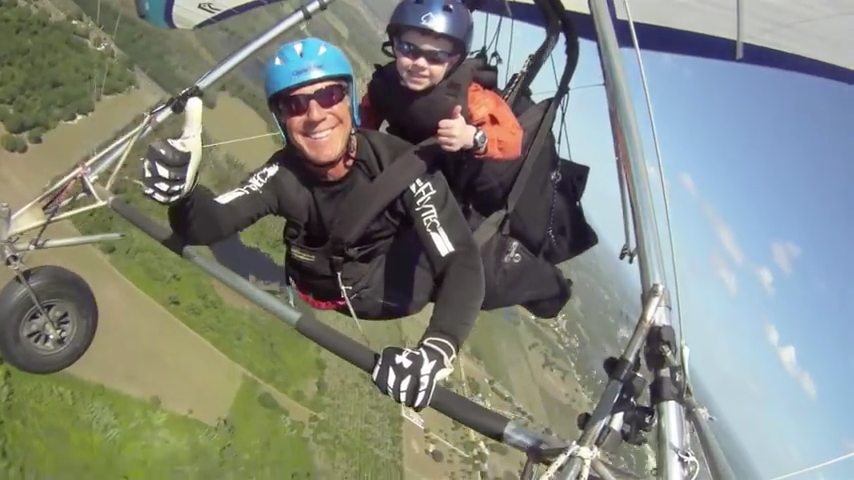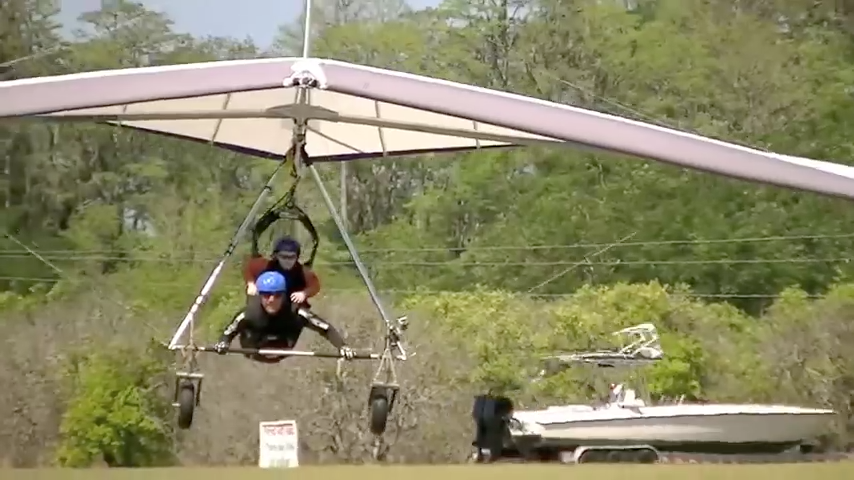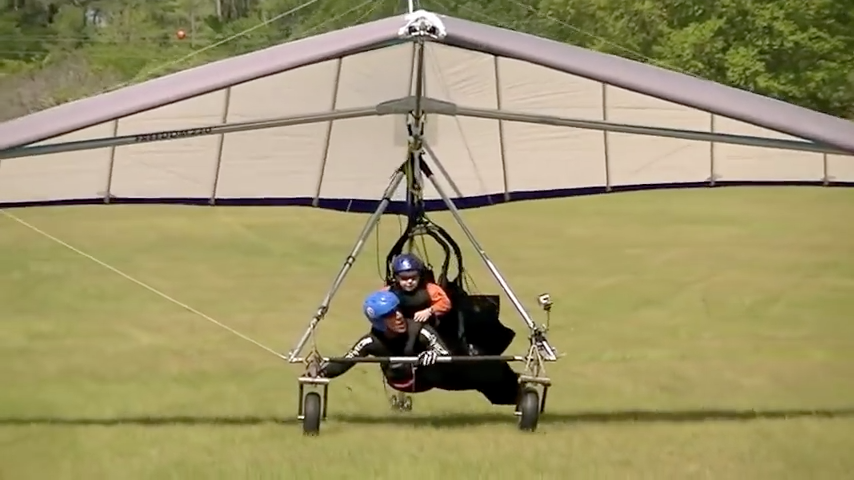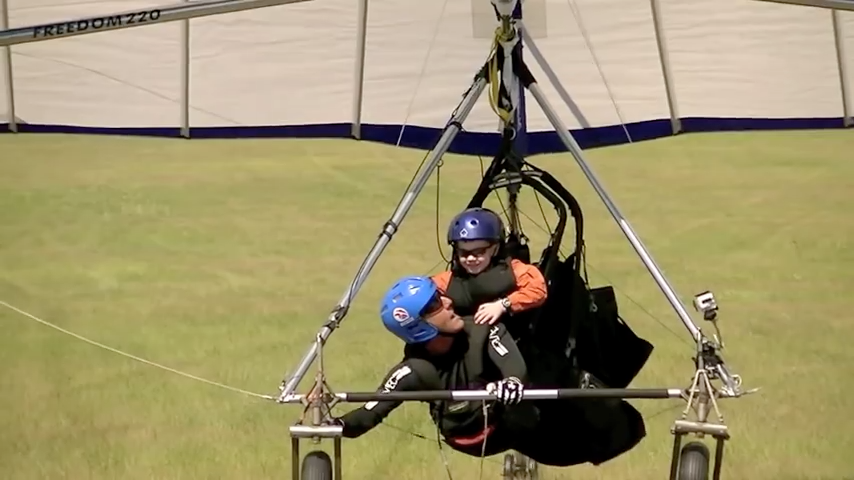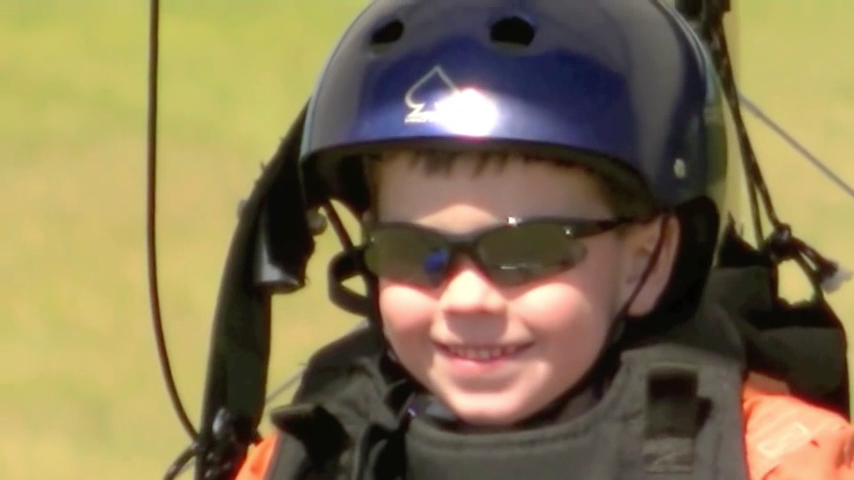http://forums.chgpa.com/viewtopic.php?t=6707
Using a drogue chute: impressions from two flights
Ward Odenwald - 2015/07/19 17:29:39 UTC
Recently, I started using a drogue chute to lower the glide performance of the LiteSpeed during landing. It's a WW chute attached to a Moyes matrix harness and as most already know, I prefer landing on my wheels (damaged/old knees) but will use the legs when the grass is long or the LZ is rocky. The Wills Wing manual does an excellent job of describing how to use it and details important safety issues for it correct use. What follows are several impressions and mistakes that may help others:
As you can see from the photos, I should have stowed my towline before deploying. As clearly stated in the manual, loose lines (including zipper lines) can become entangled in the chute lines. I was lucky that this was not an issue during both landings.
The photos also show that I was lucky in another way, in that the keel mounted camera was just far enough back so as not to catch the chute as it moved from one side of the keel to the other. When I attached the camera, the distance to the chute was not considered.
While setting up my final approach, the photos also show that during turns the chute shifts toward the direction of the turn. In other words, after initiating a turn the chute moved from near center or just off to one side to the lower wing side. This does not create a control issue when making low bank moderate airspeed turns. However, if you are using the turn to burn off excess altitude - when you exit the high bank turn your air speed has gone up significantly and so has the drag force or pull of the chute!! As a result, the chute is now pulling your center of gravity/hips toward the lower wing side and a significant amount of muscle plus reduced airspeed is required to level the wings. After a reread of the manual, there was no direct discussion of this. Next time, I’ll deploy after burning off the excess altitude and use wide turns after deploying.
Highland, with its wide-open fields, is a great place to learn how to get the most out of a drogue chute. I don't plan on using it for all landings but want to become proficient in its safe use especially for approaches into tight XC fields.
I hope this helps,
Ward
P.S. The ordered photos start with a view of my favorite landing location.
http://live.staticflickr.com/65535/53896762360_b80771a0fe_o.jpg
 http://live.staticflickr.com/65535/53896762365_3ebe7f0a43_o.jpg
http://live.staticflickr.com/65535/53896762365_3ebe7f0a43_o.jpg

Recently, I started using a drogue chute...
Can we call it a DRAG chute? That's the probable origin of the word and we use it to increase drag / decrease lift-to-drag ratio which only gets up to around 15:1 in topless bladewings which have stall speeds in the high teens.
...to lower the glide performance...
But not the stall speed.
Can you visualize any situations when lowered glide performance might not work well to one's advantage?
...of the LiteSpeed during landing.
- Sorry, I have yet to stumble across a report of you ever NEEDING to lower the glide performance of the LiteSpeed during any landing.
- Define "landing". We all know when it ends. When does it begin? How does APPROACH fit into this discussion?
- How's that been working out for you lately?
- Here's a thought... Don't deploy the stupid drag chute before you turn onto final. For any situation in which it's likely to become useful. Which we shouldn't be getting into in the first place.
- And note that once it's out it's out. It butchers your airspeed, performance, control authority and there's no way in hell you'll be able to get any of it back in an approach situation. If I could wave a wand and forever banish them I'd do it in a nanosecond. Jonathan might be a bit miffed at me 'cause he's gotten pretty good at using them safely, appropriately, effectively. But:
-- the injury he sustained because of one put the balance permanently in the red
-- I don't believe the absence of that option would cramp his XC style one iota's worth
http://www.kitestrings.org/post5882.html#p5882
20-30326
http://farm3.staticflickr.com/2860/13650864904_5d87fcc970_o.png


(Anybody else think we're seeing something of a pattern here?)
I think the primary reason you put this bullet in your Russian roulette cylinder was your refusal to get solid Downwind-Base-Final approaches - which was pretty much all I ever did after freeing my mind from the deadly u$hPa crap with which they tried to indoctrinate me early in my high flying career.
Another reason... A new glider toy with which to play. And from the manufacturers' perspective... Something else to sell to their gliders owners.
Mike Meier - 2005/08/~18
Years ago we didn't even put backup hang loops on our gliders (there's no other component on your glider that is backed up, and there are plenty of other components that are more likely to fail, and where the failure would be just as serious), but for some reason the whole backup hang loop thing is a big psychological need for most pilots.
Another backup loop. Solves nonexistent problems while causing potentially and actually deadly ones.
One time in the course of my flying career I maybe could have benefitted from a drag chute deployment.
1998/09/19, Fisher Road launch (40°05'19.52" N 078°12'58.88" W), HPAT 158, Wills Wing outboard pneumatic wheels, light SE, thermal. I'd made to the (SW) end of the finger ridge - Ritchey Knob. Couldn't maintain to make it back (to launch or the designated LZ). 40°03'37.85" N 078°15'25.16" W looked like a good option but the SW runway option was rather imperceptibly - from a bit over - downhill. Started realizing that approaching turn onto final.
Pulled in to get it down and succeeded in getting it down on the wheels. But that translated to screaming along very efficiently in ground effect forever. In hindsight now the thought now occurs to me that extending my base (there'd been no downwind) a bit (to SE) and coming back to get on final after a couple hard fast slipping turns might not have been a bad idea. And I sure wouldn't have turned down an offer of a drag chute. But I finally ran out of steam with maybe forty yards to spare.
But things were happening so fast it's questionable that I would've been able to safely deploy a chute / could've afforded the time and effort involved in deployment.
And I:
- had lost the ridge because the air was too light.
- should've realized that:
-- I'd probably be finalling downhill to some extent
-- the strength of a possible tailwind would've been negligible
And hell... When I was working at Kitty Hawk in '82 when I'd start sinking out at the North Bowl of Jockey's Ridge I'd turn my Comet 165 downwind and flare and stop on my feet just fine halfway up the slope to save myself a lot of climbing. (But of course foot landing a hang glider uphill with even a fairly strong tailwind is a total no-brainer anyway.)
It's a WW chute attached to a Moyes matrix harness...
Also designed to reduce drag to the max possible extent. And not to mention your helmet.
...and as most already know, I prefer landing on my wheels...
Wheels are for fags.
Yeah, but if you do that you'll never be able to get your flare timing perfected.
What if you have to land in a narrow dry riverbed with large rocks strewn all over the place?
...(damaged/old knees)...
They won't get any older now.
...but will use the legs when the grass is long or the LZ is rocky.
If the grass is long or the LZ is rocky it's not an LZ - it's a bail-out. And if people insist on using such areas as LZs then a lot of them are gonna get hurt. Period. Look at the LZs used for commercial and club operations. They're ALL Happy Acres Putting Greens with which sailplanes would have zero issues.
The field in which you'd intended to land on the last flight of your career was neither rocky nor overgrown with grass. It was humongous, pool table flat, as soft a place to fall on as one could reasonably ask for.
Here's a thought... Practice with it at altitude when you have nothing better to do. Get comfortable with deployment, work all the bugs out, stow it, never use it again until you find yourself in a situation in which you need it. And then don't deploy it until after you've completed your turn
onto final. Also never get into a situation in which you need to deploy it. If you do get into a situation in which you need it it's 'cause you screwed the pooch. So don't screw any pooches. And we've never heard of you being in a relevant situation.
I treated all of my landings - which were virtually all in Happy Acres Putting Greens in the same region in which you flew - as if I were coming down into turbulent postage stamps. Tight fast DBF's, often with hard slipping turns from base to final to minimize use of available runway. It was a fun way to end a flight of any length in a primary or after sinking out from an XC.
And did the Ridgely crowd ever bother to tell you about the 2012/06/06 Paul Vernon wheat field landing...
http://www.kitestrings.org/post6007.html#p6007
10-12926
http://farm3.staticflickr.com/2919/14039022660_d24ac7c976_o.png
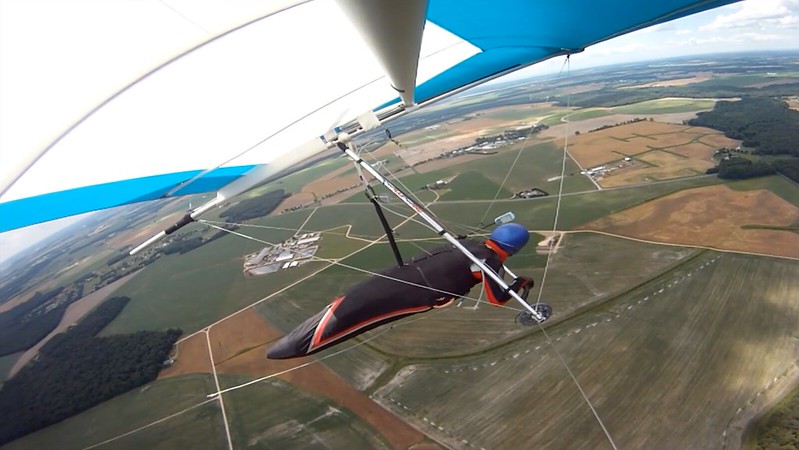
...which left him permanently vegged? (It's a good bet that if you teach people HOW to land in tall grass and crops they'll become a lot less likely to AVOID landing it tall grass and crops.)
The Wills Wing manual does an excellent job of describing how to use it and details important safety issues for it correct use.
Gotta love the irony.
The assumption being that it has a correct use.
Apparently not that excellent or effective a job.
Did it say anything about WHEN and WHEN NOT to bring it into play? Apparently not.
Lemme amend that a little. Don't use it and don't get into a situation in which it might make a significant positive difference.
Funny I can find neither a drag chute nor a manual for one on the current (Mexican) Wills Wing website.
What follows are several impressions and mistakes that may help others:
You're making potentially lethal mistakes you don't even recognize as mistakes every time you go up at Ridgely and often when you come down anywhere.
Any thoughts on CHGA's actions to weld an iron lid on the mistakes you made which cost you your life? With service above and beyond the call of duty from your great bud Rich Hiegel?
As you can see from the photos, I should have stowed my towline...
That wasn't your towline. That was your BRIDLE. And be thankful that it WASN'T your towline. Ridgely was never real concerned about ensuring that the tug's weak link was better than what was on the back end of the rope.
...before deploying.
And what did you gain by deploying on this one? (And we know what you lost by deploying on your last one.)
Probably should've lost another thousand feet before deploying. What's the point of getting a nice performing glider if you're gonna butcher half its performance with this accessory that's designed precisely for that function?
As clearly stated in the manual, loose lines (including zipper lines) can become entangled in the chute lines.
Here's a thought... Keep the chute lines out of the equation.
I was lucky that this was not an issue during both landings.
Being trapped in a pod for landing shouldn't be a big fucking deal in any halfway sane landing environment.
And we all know when your drag chute related luck permanently ran out.
The photos also show that I was lucky in another way, in that the keel mounted camera was just far enough back so as not to catch the chute as it moved from one side of the keel to the other. When I attached the camera, the distance to the chute was not considered.
You didn't consider the issue. And apparently neither did Wills Wing. Despite the fact that in this era everyone and his dog is flying with a keel mounted GoPro. (Although I am having a hard time seeing a camera being much more of an issue for the chute than the keel itself - i.e. zilch.)
While setting up my final approach, the photos also show that during turns the chute shifts toward the direction of the turn. In other words, after initiating a turn the chute moved from near center or just off to one side to the lower wing side.
Here's a thought. The airspeed felt below the wing increases from the low/slower wingtip to the high/faster wingtip. It's weathervaning a little.
This does not create a control issue when making low bank moderate airspeed turns.
Unfortunately I don't do low bank moderate airspeed turns when I'm in my pattern. I crank and bank as if I'm coming into a postage stamp. It's safe and fun and preps me for a situation I should never get into. And I can do a tight field. And with all your effort and practice with your drag chute you were unable to bring it down into one of the two designated humongous Woodstock Happy Acres Putting Greens.
However, if you are using the turn to burn off excess altitude...
If I'm using a turn to burn off excess altitude it's the one going onto final and it shouldn't be a critical one.
...when you exit the high bank turn your air speed has gone up significantly and so has the drag force or pull of the chute!!
How could there possibly be a problem with a pull of the chute working against your airspeed and glide ratio? When you're trying to get down safely in a field so restricted that use of a drag chute would be highly advantageous? (Holy shit.)
As a result, the chute is now pulling your center of gravity/hips toward the lower wing side and a significant amount of muscle plus reduced airspeed is required to level the wings.
See above about deploying a drag chute prior to being leveled out low on final. Not to mention at least very nearly into the field.
After a reread of the manual, there was no direct discussion of this.
Maybe they didn't anticipate anybody being clueless enough to deploy a drag chute prior to being on final in the field or close fucking enough.
Next time, I'll deploy after burning off the excess altitude and use wide turns after deploying.
I can hardly wait to start practicing with one of these things and mastering the techniques.
Holy shit.
Highland, with its wide-open fields, is a great place to learn how to get the most out of a drogue chute.
Highland, with its wide-open fields, is a great place to work on getting your flare timing perfected.
It's also a great place to practice DBF approaches:
- but if you're turning onto final at two hundred feet it's not doing you much good for your ability to put it down safely in a tight field when you're flying XC
- which will reduce to zilch the probability that the safety of a future landing will ever depend upon the deployment of a drag chute
One would think that Highland, with its wide-open fields, would be a great place to land a high performance blade wing without flying into a taxiway sign and breaking arms in three places in sled conditions. Nevertheless we had a carrier pilot do just that. And the real tragedy was that he came up short of his intended spot.
Yep. Hard to go wrong practicing emergency procedures in environments with zero similarities to the ones in which the equipment might me of some possible use. Shark repellent in Death Valley. See how great it works?
Maybe you should be thinking more about getting the least out of a drag chute. But:
- you never did.
- thanks bigtime for writing your own fatality report six years plus seven and a half months prior to actual event. Crystal ball? Time travelling?
This is a lot like getting the most out of your automobile brakes. The goal is to get the LEAST out of them.
- safe, moderate, steady, fuel efficient speed
- monitor traffic, lights far ahead
- foot off the gas immediately when:
-- traffic ahead slows or stops
-- the next light turns yellow
- downshift / employ engine braking
- lightly, smoothly apply braking as needed
The difference is that you tend to be safer at low (ground) speeds in cars and at reasonably high speeds for aircraft.
I don't plan on using it for all landings but want to become proficient in its safe use especially for approaches into tight XC fields.
Oh really. Tell us about your approach on final at 2022/03/03 20:10 UTC to a pancake flat cleared field area with two thirds of the runway potential of the paved Ridgely one.
And what's the worst that could possibly happen in what is virtually always the most critical phase of hang gliding (or any other flavor of aircraft) flight as a consequence of lowered glide performance?
IF you do one of these you DON'T do it for APPROACHES. You do it when you're IN the field. AFTER you've gone onto final and are clear (enough) of the downwind trees or powerlines.
This:
07-1014
http://farm9.staticflickr.com/8604/16469500399_1f72de17ae_o.png
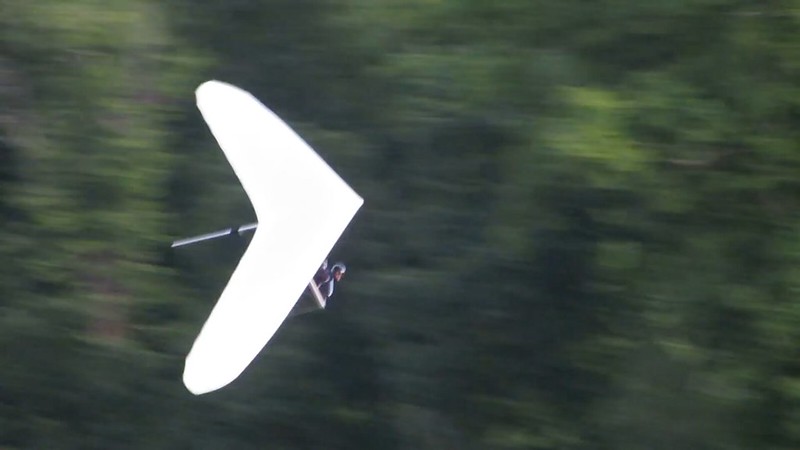
is what you need to be planning to do for ALL landings in zilch to moderate air for EVERY landing. And it takes very little in terms of proficiency and/or currency. I haven't flown for close to sixteen years but I could still pull one of those off in my sleep.
And fuck all the u$hPa instructors - Joe Greblo in particular - who teach anything else at Two level and beyond.
And if you're using wide turns after deploying you haven't come anywhere close to burning off excess altitude. And I don't think you have a workable concept of the meaning of excess altitude. Probably not minimum altitude either - based upon the results of the last approach of your life.
Tell us about some of these tight XC fields into which you've landed. I have yet to stumble across a reference. And if you were unable to put it down in the vastly superior of the two brain dead, sled accessible Woodstock fields on 2022/03/03 I can't imagine you surviving many XC landings in actual tight fields. And when I was flying XC in some of the same areas you were I don't recall being unable to keep brain dead easy stuff in comfortable range at all times.
How's that working out for ya? You just wrote the fatality report that your ol' flying buds went to so much effort to suppress.
It doesn't have a safe use. It seriously compromises the performance of your glider. Become proficient in staying out of situations requiring its safe use.
I hope this helps,
Ward
Yeah Ward, this helps. More than you could possibly imagine. Just not quite the way you intended. And the costs of your glider - and life - outweighed the benefits. 'Specially with your ol' Capitol Club buds - including and especially Rich Hiegel - working their butts off to suppress any useful information on this incident.
Yeah, but not for you. And one of the things your highly valued CHGA friends are worried about is your family suing Wills Wing outta existence. Reminds me of Arys Moorhead and the stupid Wills Wing outboard wheels - the axle of the port one of those which snagged the tow bridle after things started going seriously south on Kelly Harrison's total clusterfuck of a tandem thrill ride operation.
And let's reverse roles here. You're standing in the bridge field as Rich comes up a bit short 'cause of his landing safety enhancing drag chute. Are you gonna go off the reservation and blow the whistle? Like I did very shortly before your re-entry into the sport? Which I one hundred percent guarantee you would've ended your flying career too?
Nah, they liked you dead a lot better than they would've alive if you'd taken that route.
I haven't flown since the end of the season prior to the one of your re-emergence. Crossed paths with you a few times back in the day, knew of and was impressed by your accomplishments and seeming expertise, was saddened and mystified (as was the intent of your great CHGA / u$hPa / Industry buds), finally decided to take a shot at cracking the code. And succeeded beyond my wildest dreams.
And even if I'm totally off the mark - which I don't believe for a nanosecond - it doesn't matter. You still wrote a major book on great ways to kill oneself in the approaching, landing, equipment, mindsets departments.
P.S. The ordered photos start with a view of my favorite landing location.
Shouldn't have been. It should've been a great place to learn and practice techniques for landing in demanding circumstances but I always had a blast approaching and parking in the Woodstock primary with minimum consumption of runway - and zero interest in moronic spots.
And we know what suddenly became your least favorite landing location during the last few seconds of your flying career - and life.
A lot of what you achieved up over the ridge and valley outmatched what I was able to accomplish in the years that I had but the end of the flight phase... Stunningly misdirected and clueless. Not to mention the total crap you were flying with and doing at the Ridgely operation.
And note we never had any of that crew emerge from the woodwork in response to your sad and totally needless passing.
---
In the course of composing this one I've found/realized that this:
http://forums.chgpa.com/viewtopic.php?t=7349
Woodstock, Thursday (9/28)
is the last record we have of Ward deploying his drag chute at the end of any flight anywhere. He makes no mention of it and his stills of his flights either don't include the landing or illustrate in no uncertain terms that it wasn't deployed.
I'm thinking he may well have gotten a bit tired of this thing butchering his performance and control on approach and cutting into his fun factor. But his second to last high flight (also at Woodstock) was 2021/11/19 - three and a third months prior - so maybe time to get things outta mothballs, blow the dust off, do a refresher with the drag chute.
That's a reasonable hypothesis, his buds are gonna maintain the code of silence until their deaths, we have no shortage of unpleasant and ugly drag chute incidents, Ward had documented it butchering his control authority, it's designed to butcher the kite's glide performance, so let's go/stay with it. When most of us hear hoofbeats we shouldn't immediately start thinking about zebras.
Also - for what it's worth - Ward never published that after a considerable test flying time with his chute he'd started having serious second thoughts on the issue.


